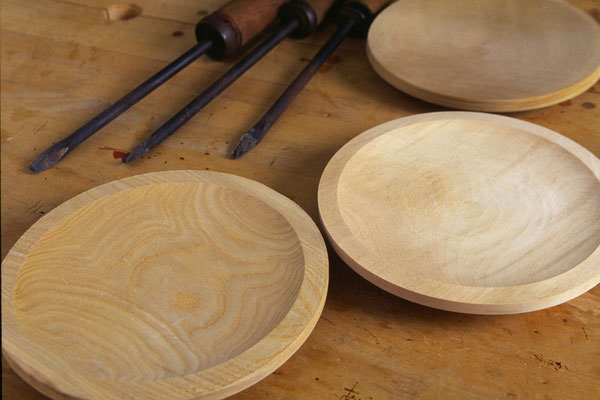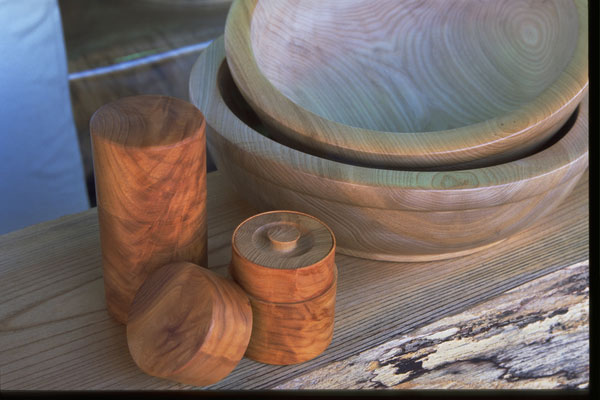 Photo:Shinshu・Nagano Prefecture Tourism Association
Photo:Shinshu・Nagano Prefecture Tourism Association
- Wood, bamboo crafts
- Nagano
Nagiso woodturning Nagiso rokuro zaiku
Top-level artisans make smooth and unique planing
Natural woodwork showing the best of the grain
Description
What is Nagiso woodturning ?
Nagiso Rokuro Zaiku are completely handmade woodwork items made in the area around Nagiso Town, Kiso-gun, Nagano Prefecture. This traditional craft originated in the first half of the 18th century and is known for a special skilled manufacturing called rokuro zaiku, a special type of wood turning. In Rokuro Zaiku, plain-wood products are made from a round wood slice planed while being turned on a lathe. As the whole process is done manually, high level skills and an extensive knowledge of the properties of wood are required; masters of the craft are known as kijishi. Nagiso Rokuro Zaiku are distinguished by their beautiful wood grain that is brought out by this unique method of turning. Nagiso Rokuro Zaiku mainly include plain wood bowls and lidded containers to store tea sets. Products are made taking into account the color, grain and type of wood; the quality of wood harvested from the verdant forests of Nagiso is what makes Nagiso Rokuro Zaiku so attractive.
History
 Photo:Shinshu・Nagano Prefecture Tourism Association
Photo:Shinshu・Nagano Prefecture Tourism Association
As there are records of Nagiso Rokuro Zaiku trays and plain-wood products being shipped to Nagoya and Osaka, the beginning of the craft is thought to date back to the early 18th century. However, the kijishi who made Rokuro Zaiku plain-wood products are believed to have been active in the 1500s, as shown by licenses issued at that time for cutting down trees. Omi (current Shiga Prefecture) is believed to be the place of origin and it is known where kijishi were cutting trees to make such products. They are also known to have come to Nagiso and to have developed the present Nagiso craftwork. There are also records of plain wood products being produced in the mid-Edo period, and since then, kijishi in Nagiso gathered together and established a "kijishi's village". With the coming of mechanization and electricity, fewer and fewer artisans carry out their work without powered machinery, and today an electric lathe is generally used.
General Production Process
- 1. Selecting wood Each piece of Nagiso Rokuro Zaiku is made by just one artisan from locally grown trees, such as Japanese horse chestnut, zelkova, castor aralia and Japanese judas. Trees are carefully inspected and those suitable are cut and the bark is stripped off. Then, any marks or stains are removed with tools. The artisan checks when the tree was cut, the growth process, and characteristics of the wood by observing the end surface and the surface on the sides, to classify the wood for making different items.
- 2. Preparing the timber The selected wood is cut into round slices by cross-cutting. Round slices are placed with the cut surface facing up, and sawn lengthwise. The sawn wood is then shaped into a circular or elliptical shape. The outer side of the wood is removed to carefully bring out the wood grain, and finally, a lathe is used for rough turning and planing.
- 3. Drying After rough turning, the wood must be dried for hardening. It is left in a place with a stove or an open hearth, and is dried slowly for about three months to remove excess moisture. The drying time varies according to the size of the wood and the amount of moisture, and it could be as long as three years for a large wood piece. The degree of dryness is important and the water percentage is measured periodically until it reaches 10%. The wood is then exposed to the open air until the moisture content rises back to 12%, and the drying process is complete.
- 4. Final turning The wood is placed on a lathe and smoothed with a plane. This is a highly skilled task and requires many years of practice to master the technique. Kijishi artisans have a variety of planes and make their own planes for each item, such as those for rough shaping in rough finishing, final turning, and those used for finishing. After the final turning, a final light sanding is given with sandpaper.
- 5. Finishing To finish, pieces are either polished in water with scouring rush to bring out the wood grain, or given a coating of natural lacquer and polished. Both methods bring out the attraction and simplicity of natural wood as those polished with scouring rush become plain wood products and those with a lacquer coating are lacquered, but maintain the appearance of the wood grain. The smooth surface is a much unique characteristic of wood turning, and chabitsu (containers to store tea sets), bowls, and trays made with this wood turning method really do express the warmth of wood.
Where to Buy & More Information
Kiso Kurashi No Kogeikan
-
Address
-
Tel.+81-264-34-3888
-
Business Hours9am to 5pm (shorter business hours from the middle of December to the middle of March)
-
Website
See more Wood, bamboo crafts
- Hakone wood mosaic
- Iwayado traditional chest
- Kaba cherrybark woodcrafts
- Odate bentwood
- Inami wood carvings
- Matsumoto furniture
- Beppu bamboo crafts
- Edo wood joinery
- Ichii woodcarvings
- Suruga bamboo crafts
- Edo bamboo fishing rods
- Kishu bamboo fishing rods
- Kamo traditional chest
- Kyo wood joinery
- Miyakonojo archery bows
- Osaka carved wooden panel
- Miyajima woodwork
- Nibutani carved wooden tray
- Okuaizu Basketry
- Echizen traditional chest
- Kasukabe traditional paulownia chest
- Katsuyama bamboo crafts
- Osaka karaki wood joinery
- Takayama tea whisks
- Toyooka wicker crafts
- Akita cedar tubs and barrels
- Nagiso woodturning
- Kishu traditional chest
- Nagoya traditional paulownia chest
- Osaka bamboo screens
- Osaka-senshu traditional paulownia chest
- Sendai traditional chest































































































































































































































































































